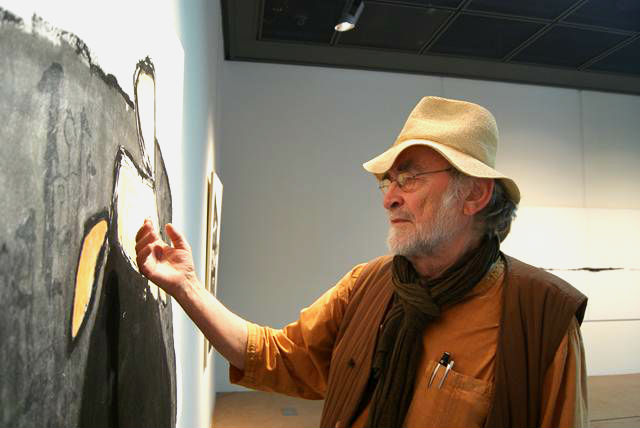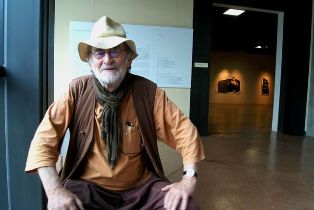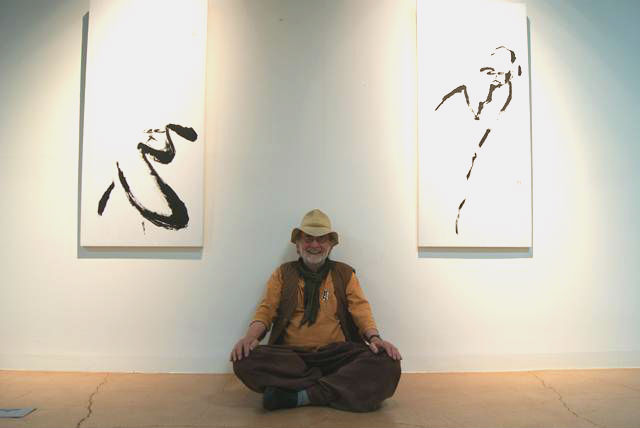| |
 |
|
| “Normally I never have a subject, I just follow the brush," says German Werner Sasse about his work. Photo by Darren Southcott |
Werner Sasse’s work has an ephemeral air. Tacks pin down curled corners and free-flowing brush strokes, in the traditional Korean style, leave black ink trails across the thin white hanji paper.
Although much of the work on display at the Obaek Janggun Gallery, Jeju Stone Park, was produced over a month specifically for the exhibition, this is not the norm for the German-born scholar and artist.
“Normally I never have a subject, I just follow the brush. Of course, I have some kind of image in my mind but that goes away as soon as I start painting.”
“The first stroke really does something on the paper, and from that moment you start balancing, counterbalancing, looking at the spaces you have created, looking at the lines and their direction and their intimacy,” he says.
Is he ever unhappy with what his mind produces?
“When there is something wrong in the picture, I very, very seldom throw it away. I just leave it there, sometimes for a week or two, and then suddenly [clicks fingers] it comes.”
What is this inspiration?
“It,” he says, “It just comes.”
A spiritual energy?
“I don’t know what it is. My fantasy? My experience? If I were religious I would say, in the Buddhist sense, ‘it’ is doing it,” he says. “We kid ourselves into thinking we are acting, but in most actions ... something else is guiding us, making us do it.”
Released from academia
| |
 |
|
| ▲ “I was not following any rules — I made the rules.” Photo by Darren Southcott |
Sasse now luxuriates in the freedom of the brush after a five-decade academic career in which the direction for his academic work was intuitive, yet necessarily restricted.
“I was not following any rules — I made the rules.”
Art, however, was always in Sasse’s soul, and as a teenager he ran away to an art school in St. Ives, England, only to be tracked down by his father — who pushed him toward academia — and dragged home.
Exiled into scholarship, Sasse’s creative and abstract mind sought expression in his scholarly pursuits, displaying a rare brilliance.
In producing his habilitation thesis on Shilla poetry at Bochum University, he was inspired by Enigma code-cracker Alan Turing. After seeking feedback from a maths professor colleague about his attempts at deciphering Middle Korean, he was called both an idiot and a genius.
It was his intricate statistical method developed from linguistic structures that was genius. “Give me the idiot,” said Sasse.
“The method has been done by Aristotle,” quipped the professor.
Coming from within
Perhaps it is Sasse’s Aristotelian idiocy that is guiding his art, although he prefers the inner self. In essence, he says, it is something produced, “in the dialogue with the paper.”
And, as in any dialogue, meaning is open to both interpretation and reinterpretation, suggesting visitors “walk around in the picture and finish it yourself.”
“Very often I have an idea when I finish, but six months later I look at it and it is a completely different picture and I say, ‘Hey, I did that?’ “
Such openness is a feature of the Eastern tradition, which doesn’t seek to “get rid of the empty space” like Western art, says Sasse.
“The empty space, that is where it happens. You have something up here and something down here, and in the middle is nothing. That is where it happens.”
Leading me to the dharma
I ask Sasse which image is most meaningful to him. He immediately approaches two images displayed side by side representing Buddhist dharma.
They were produced after meditating on a Buddhist sermon. The inspiration came in a flash after reflecting on a friend’s video lecture.
“I didn’t do anything for a long time, and then within a minute this one was finished. I looked at it and said, ‘Yeh, that is dharma.’ And then in another minute, this one.”
Despite only taking seconds to complete, Sasse was exhausted mentally.
“It was very emotional to do, first the meditation and then that. And once it was finished I said ‘aaaaah’ [exhales].”
| |
 |
|
| Sasse sits below his two images of Buddhist dharma: "It was very emotional to do." Photo by Darren Southcott |
Jeju’s solidity
This earlier work, more “esoteric,” says Sasse, is not as heavy and solid as the work produced on Jeju, reflecting the context of the island itself.
“You constantly have to work against this stone all the time in your consciousness. ... Jeju is a challenge to the people, and for me I have to pull my strength together against this overwhelming solidity.”
Religious influences are common in this series also, and after living here for a year and visiting many times, he says he has naturally absorbed Jeju’s mythology, landscapes and iconography.
“It is not that I paint Jeju-do. It’s ‘I paint,’ and this is part of my experience.”
“Sometimes I later realise that there was a memory connected with it. The stroke, in the way it is, evokes a memory of something. But often I really don’t know.”
An exile in the land of exile
Sasse once described himself as in exile, which seems to reflect the very essence of his art. Seeking and searching is the human condition, he says, much like the movements of his brushstroke on the paper.
“His body is somewhere, his mind is somewhere, but in reality he is on the way to somewhere ... he is on the way.”
Does Jeju, the land of exile, represent the end of his journey?
“I will be on the way all the time ... I accept it.”
The 'Werner Sasse' exhibition is open until July 7 at Jeju Stone Park. Click here for an interview with Stone Park founder Paek Uncheol or click here for the Stone Park homepage. |






















